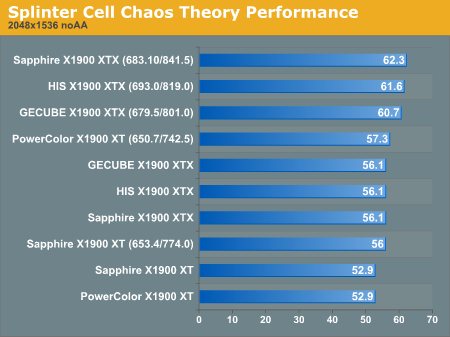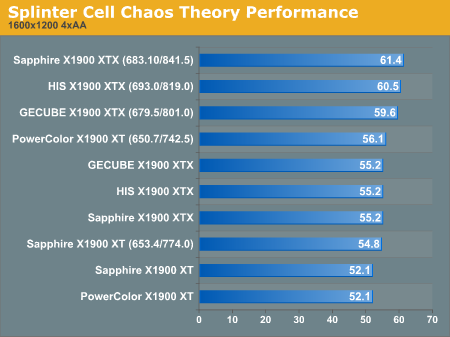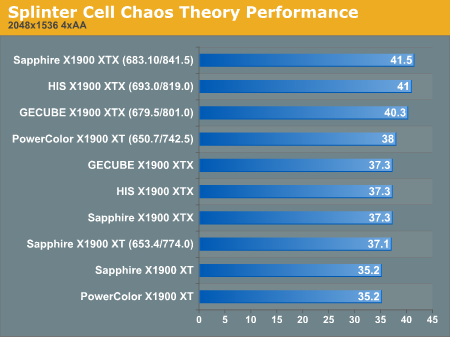X1900 XT/XTX Roundup: A Closer Look at the Performance Leader in Graphics
by Josh Venning on February 15, 2006 4:00 PM EST- Posted in
- GPUs
Overclocking/Power Load/Noise
Overclocking these cards was somewhat difficult, as the usual tool that we use (Powerstrip) didn't support the X1900 yet. Instead, we used a program called ATITool to get our overclocks. Unfortunately, we found that ATITool's listed speeds didn't quite indicate actual performance speeds perfectly, so the clock speeds that we were able to achieve yield slightly lower performance on the card. We were, however, able to get a good idea of the overclocking abilities of these cards with this tool. Here are the clock speeds that we achieved:
Splinter Cell Chaos Theory Performance
The first thing we can point out here is that the Sapphire X1900 XT did in fact achieve clock speeds slightly higher than a stock X1900 XTX. This is an important discovery, as it may give pause to those who would be quick to choose an X1900 XTX over the less expensive XT. The fairly large difference in price between the two cards is enough to justify buying the X1900 XT and attempting to clock it up to XTX speeds. It's true that the PowerColor X1900 XT didn't quite get up to XTX speeds (650/775), which indicates that not everyone will have this kind of success overclocking their X1900 XT. However, as the graphs show, the performance of the PowerColor X1900 XT and the reference X1900 XTX are close enough to each other. So, the fact that the PowerColor has a slightly lower clock is unimportant.
Overall, the overclocks varied quite a bit with the different cards. The XTXs in particular all achieved memory clocks very different from one another, with the GeCube X1900 XTX doing the worst. The Sapphire cards seemed to overclock the best, something that isn't very surprising given our experiences with their cards in the past. The GeCube and PowerColor X1900s achieved the lowest overclocks, with our GeCube being particularly finicky (crashing, artifacts, etc.). Bear in mind, however, that many cards of the exact type can overclock very differently from one another, so this might not be the case for all GeCube X1900 XTXs.
Power Load
To test the power load of the card, we measure the total watt usage of our test computer at the wall outlet, recording the power usage of our system in two different states. The first state is with the card installed and the computer at idle, and the second is during intensive performance tests (looped Splinter Cell benchmarks). This doesn't give us an exact power measurement of the card, but it helps us get an idea of the kind of power the card pulls.
Interestingly, the X1900 XTs and XTXs drew very similar loads. Of the XTXs, the HIS X1900 XTX drew the smallest amount of power under load, which isn't that surprising given its unique HSF. The Sapphire and GeCube XTXs drew nearly the same amount of power under load. We can see that the X1900 XT does pull a slightly lower load than the XTX, but these are both incredibly power-hungry cards.
Noise
Again, we see that the HIS X1900 XTX stands out somewhat as being slightly more quiet than the other cards, likely due to the different HSF. All of these cards are a bit noisier than most, but this isn't very surprising given their enormous power. For reference, the noise level of the room with the system off was 40.6 dbl.
Overclocking these cards was somewhat difficult, as the usual tool that we use (Powerstrip) didn't support the X1900 yet. Instead, we used a program called ATITool to get our overclocks. Unfortunately, we found that ATITool's listed speeds didn't quite indicate actual performance speeds perfectly, so the clock speeds that we were able to achieve yield slightly lower performance on the card. We were, however, able to get a good idea of the overclocking abilities of these cards with this tool. Here are the clock speeds that we achieved:
| Overclock speeds | ||
| Graphics Card | Core (in MHz) | Memory (in MHz) |
| PowerColor X1900 XT | 650.7 | 742.5 |
| Sapphire X1900 XT | 664.2 | 774.0 |
| Sapphire X1900 XTX | 688.5 | 841.5 |
| GeCube X1900 XTX | 679.5 | 801.0 |
| HIS X1900 XTX | 697.5 | 819.0 |
Splinter Cell Chaos Theory Performance




The first thing we can point out here is that the Sapphire X1900 XT did in fact achieve clock speeds slightly higher than a stock X1900 XTX. This is an important discovery, as it may give pause to those who would be quick to choose an X1900 XTX over the less expensive XT. The fairly large difference in price between the two cards is enough to justify buying the X1900 XT and attempting to clock it up to XTX speeds. It's true that the PowerColor X1900 XT didn't quite get up to XTX speeds (650/775), which indicates that not everyone will have this kind of success overclocking their X1900 XT. However, as the graphs show, the performance of the PowerColor X1900 XT and the reference X1900 XTX are close enough to each other. So, the fact that the PowerColor has a slightly lower clock is unimportant.
Overall, the overclocks varied quite a bit with the different cards. The XTXs in particular all achieved memory clocks very different from one another, with the GeCube X1900 XTX doing the worst. The Sapphire cards seemed to overclock the best, something that isn't very surprising given our experiences with their cards in the past. The GeCube and PowerColor X1900s achieved the lowest overclocks, with our GeCube being particularly finicky (crashing, artifacts, etc.). Bear in mind, however, that many cards of the exact type can overclock very differently from one another, so this might not be the case for all GeCube X1900 XTXs.
Power Load
To test the power load of the card, we measure the total watt usage of our test computer at the wall outlet, recording the power usage of our system in two different states. The first state is with the card installed and the computer at idle, and the second is during intensive performance tests (looped Splinter Cell benchmarks). This doesn't give us an exact power measurement of the card, but it helps us get an idea of the kind of power the card pulls.
| Graphics Card | Idle | Load |
| PowerColor X1900 XT | 146 | 315 |
| Sapphire X1900 XT | 148 | 316 |
| Sapphire X1900 XTX | 151 | 336 |
| GeCube X1900 XTX | 154 | 337 |
| HIS X1900 XTX | 152 | 330 |
Interestingly, the X1900 XTs and XTXs drew very similar loads. Of the XTXs, the HIS X1900 XTX drew the smallest amount of power under load, which isn't that surprising given its unique HSF. The Sapphire and GeCube XTXs drew nearly the same amount of power under load. We can see that the X1900 XT does pull a slightly lower load than the XTX, but these are both incredibly power-hungry cards.
Noise
| Graphics Card | dbl level |
| PowerColor X1900 XT | 52.0 |
| Sapphire X1900 XT | 49.6 |
| Sapphire X1900 XTX | 50.2 |
| GeCube X1900 XTX | 51.4 |
| HIS X1900 XTX | 49.5 |
Again, we see that the HIS X1900 XTX stands out somewhat as being slightly more quiet than the other cards, likely due to the different HSF. All of these cards are a bit noisier than most, but this isn't very surprising given their enormous power. For reference, the noise level of the room with the system off was 40.6 dbl.










25 Comments
View All Comments
spinportal - Monday, May 1, 2006 - link
Anyone getting a graphics card at this point in time should wait for the fall refresh.1. You'll kick yourself in the head when you realize you want free h.264 full 1080p decompression software (nVidia needs to wake up and drop the charge)
2. I hate DVI pins, and HDMI cables should be the new standard, however, which version? And no need for audio lines. Oh well.
3. Manufacturers might piggyback the Aegia ppu as that matures.
4. DX 10 support (get ur Vista on!)
5. HDCP support (better the have it enabled, then say, Oh its there, but its missing something, but we got it! Whatever nVidia & ATi sales sharks)
6. ATi needs to shrink their die, refreshing the R580 for less heat and smaller cooling card systems while giving a bit of a core clock increase. There is no sense to having an XT and an XTX card in the product line if they are that close in price and performance, as an XT is not a "bargain" and an XTX cannot go full-tilt with Crossfire. Pure marketing sillyness.
7. nVidia's fall refresh might address HDR+AA? Well, at least both companies are on a full 32-bit back buffer finally? What is nVidia going to counter with this Sept? Will dual-7900GTX GPU (internal SLI w/ autoconfig superblocking / tiling / afr) boards be their marketing hype instead of releasing a new architect? Will SLI and Crossfire mobo chipsets be unnecessary and finally be interchangable? I suspect nVidia would want to keep its lock-out of XFire on its nForce chipset, and vice-versa. I hate being strongarmed, but who knows what Joe Consumer will do about it? Besides, SLI is more for people who have $$ to burn for top-end, than someone on a modest budget looking to add a 2nd 6600GT card.
8. Mobile scene is dominated by the GeForce Go 7900. ATi has inroads on system builders with integrated graphic chipsets. We see each company pursuing their own path. Will the laptop market increase and box system sales decrease? This might shift the gpu companies business model as more folk lean toward mac Mini / laptop / DTR / XPC style machines for low power and low noise.
shortylickens - Tuesday, February 21, 2006 - link
Is there some reason they chose not to add F.E.A.R to this benchmark session?Guspaz - Saturday, February 18, 2006 - link
"above a CG ninja-like female with a sword"Umm, yeah... About that... That is Ruby, ATI's official mascot. Nice to do some research into the company who's GPUs you're reviewing first.
Per Hansson - Friday, February 17, 2006 - link
"The HIS X1900 XTX drew the smallest amount of power under load, which isn't that surprising given its unique HSF."Reality check; the HSF on a vidcard draws about 0.2Ah, the difference you are showing is from insufficient testing methods. A drop in line voltage from 110 to 105v would have a tremendeous (realtive) difference in your charts
If you really are interested in the power consumption of these cards look at this article instead
http://www.xbitlabs.com/articles/video/display/gpu...">http://www.xbitlabs.com/articles/video/display/gpu...
DerekWilson - Friday, February 17, 2006 - link
cooler chips draw less power.SkyBum - Thursday, February 16, 2006 - link
I'm just curious why the ATI branded 1900's were not included in this review. I was hoping to see a comparison of benchmarks between the ATI and the partner offerings.Spacecomber - Thursday, February 16, 2006 - link
While I understand the rationale of a roundup of similar cards, all this discussion about how noisey these cards seem to be highlights an essential problem with these roundups. Their narrow focus prevents them from being as helpful as they might otherwise be. The bottom line of this roundup seems to be that all these cards are fairly noisey. In other words (as is typically the case with these roundups), all the cards in the roundup turn out to be more alike than different.Since noise was flagged as an issue with these 1900 cards, where do they stand relative to other top end cards, such as the 7800s? Are these any less noisey? The problem with these roundups is that they offer no useful points of easy reference when trying to understand the relative strengths and weaknesses of the cards in the roundup, because there is no larger context offered.
Although this roundup offered a link to an earlier article discussing the 1900s vis a vis the 7800s, you'll search in vain in that article for any mention of fan noise.
I'd really like to see Anandtech move away from what seems to have become a rather tigthly pre-formulated format for their articles. I often find myseld wondering why the reviewer isn't exercising more flexibility in their approach and allowing the pecularities of whatever products are under review to guide the direction and content of the article a bit more. It's as if the reviewers can only ask and try to answer certain questions in a review, and anything beyond that is out of bounds, even if it might be more interesting than the standard pictures, descriptions, and graphs.
In the end, the impression one gets is that for the reviewers writing these articles it is just a job and that the reviewer doesn't really find computer components to be all that interesting or exciting. There is no sense of any personal questionning or curiousity about the product. While that would be fine if we were just considering advertisement copy, that's not what I'm hoping to find at Anandtech.
Anand started writing articles about computer hardware because he was eagerly evaluating and considering what he would like to get his hands on and play with himself. He was drawn to the hardware and wanted to know everything he could about it. I think that its fair to say that many of AT's avid readers have a similar hunger for and curiousity about what's new with computer hardware. Unforutnately, many of anandtech's articles are beginning to sound like the people writing them are no longer so interested in computer hardware. The curiousity to get below the surface and delve into the details is gone. In this article, for example, heatsinks are no longer removed and the memory on a video card examined to see if different card makers are using faster or slower rated memory on their otherwise similar cards.
Alright, time to get off my hobby horse.
Space
AGAC - Thursday, February 16, 2006 - link
Dear Mr. SpaceBeing a Brazilian citizen, English is not my native language, so forgive my bad grammar. You comment just reflects my first impression when I started to read this article: "But they are all the same".
I want to upgrade my graphics card and I don´t care if my card is not the fastest thing on earth although I want to have something at the higher end of the spectrum.
Noise is a very important concern because my computer have meny other uses than just play games. It´s about ergonomics, power comsumption, heat that makes me wonder that the virtue is in the midle.
A roundup of identical twins will not help me decide. Perhaps it helps me in a negative
way, telling me that none of these nice cards will fit my bill. Still the most important question remains unanswered: Which one does?
Comparison envolves a much harder work than just bench the cards and conclude some thoughts. This is like scratching the surface not worth to be an Anand Tech article.
I have been told that some 7800 GT are not that loud and slouch they certainly are not. Just would like to find out here at Anand Tech because I learnt to respect the judgement of its reviewers.
BTW, I just upgraded my monitor to a 1600*1200 20' Samsung LCD. SLI is too exotic to my taste and I am looking for a PCIe video card that would allow me to play ocasionaly at the native resolution. Being a sensible AT reader, I hope you can give me a tip on that one.
Thanks and regards from Brazil
AGAC
Spacecomber - Friday, February 17, 2006 - link
Since I don't own a video card that I think would fit your needs (my 6800GT is fine for playing Battlefield 2 at 1024x768, but I wouldn't suggest it for resolutions much higher than that), I probably am not the one to try and answer your question. I'd suggest that you check out the video forums here at Anandtech and pose your questions there. Plenty of members are running large LCDs such as yours and they could give you some direct experience on what video cards are up to this job and which ones aren't.As far as video card fan noise goes, in some cases there are some good 3rd party heatsinks, such as those from Zalman and Arctic Cooling, which are quieter than the standard heatsinks. The manufacturer's website and Anandtech forum members should be able to help you make sure that you get the right heatsink for the card you are interested in, if you decide that you want to go that route (you want a heatsink that will properly fit on your card and have the cooling capacity to deal with heat produced by that particular graphics chip).
I remain a big fan of Anandtech and think that you will find what you are looking for here.
Space
LoneWolf15 - Thursday, February 16, 2006 - link
They're fast. But they're noisy.At any rate, I don't think I'll be able to justify upgradint either my 19" CRT or my Radeon X800XL until we see how the whole HDCP fiasco shakes out. Currently no vid cards are HDCP compliant*, which has the potential to really stink if the content industry has its way.
*note: some GPU's are supposedly HDCP-compliant, but the cards they are on are not, as the standard seems to be in flux.